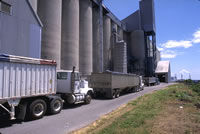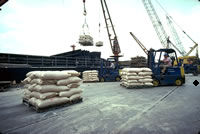Pocket K No. 8: Cartagena Protocol on Biosafety
| |
|
In 1994, the first genetically modified food crop, Calgene’s Flavr-SavrTM tomato, was produced and consumed in an industrialized country. Since that time, genetically modified (GM) crops have been rapidly adopted worldwide reflecting the satisfaction of growers. While advances in biotechnology have great potential to improve human well-being, the technology must be developed with adequate safety measures. The Cartagena Protocol on Biosafety is a legally binding global protocol that seeks to contribute to ensuring the safe transfer, handling and use of living modified organisms (LMOs) created through modern biotechnology.
What is the Protocol’s objective?
Article 1 of the Protocol states that it aims to “contribute to ensuring an adequate level of protection in the field of the safe transfer, handling and use of living modified organisms resulting from modern biotechnology that may have adverse effects on the conservation and sustainable use of biological diversity, taking also into account risks to human health, and specifically focusing on transboundary movements”. In short, it seeks to protect biodiversity from the potential risks of living modified organisms (LMOs) resulting from modern biotechnology.
What does the Protocol cover?
|
The Protocol covers the “transboundary movement, transit, handling and use of all living modified organisms that may have adverse effects on the conservation and sustainable use of biological diversity, taking into account risks to human health”.
It does not cover:
- Products derived from LMOs (e.g. paper from GM trees)
- LMOs, which are pharmaceuticals for humans that are addressed by other relevant international agreements or organizations
What is the Biosafety Protocol?
The Cartagena Protocol on Biosafety is a legally binding protocol to the Convention on Biological Diversity (CBD). It was named in honor of Cartagena, Colombia, where negotiations were expected to conclude in February 1999. One year later, on January 29, 2000, the Protocol was finalized and adopted in Montreal, Canada by unanimous consent with 135 countries present.
What does the Biosafety Protocol do?
|
It assists developing countries in building their capacity for managing modern biotechnology
- It creates an advanced informed agreement (AIA) procedure that requires exporters to seek consent from importing countries before the first shipment of LMOs meant to be introduced into the environment (e.g. seeds for planting, fish for release, and microorganisms for bioremediation)
- It establishes an internet-based “Biosafety Clearing-House” to help countries exchange scientific, technical, environmental and legal information about LMOs.
- It requires bulk shipments of LMO commodities, such as corn or soybeans that are intended to be used as food, feed or for processing, to be accompanied by documentation stating that such shipments “may contain” LMOs and are “not intended for intentional introduction into the environment”.
- The Protocol includes a clause that makes clear the Parties’ intent that the agreement does not alter the rights and obligations of governments under the World Trade Organization (WTO) or other existing international agreements.
What does the Biosafety Protocol Not do?
- The Protocol does not address food safety issues. This is addressed by experts in other international fora.
- The Protocol does not require segregation of bulk shipments of commodities that may contain living modified organisms.
- It does not require consumer product labeling.
- It does not subject shipments of bulk commodities to the Protocol’s AIA procedure.
The Protocol will enter into force 90 days after it is ratified by the 50th state or regional economic integration unit.
As of June 2002, 103 countries have signed but only 21 have ratified. When a country signs the Protocol, it signifies its general support for the principles in the Protocol and commits to take the steps necessary to consider and pursue its ratification. The Protocol only becomes legally binding when a country deposits an instrument of ratification with the United Nations.
Key Features of the Protocol
Advanced Informed Agreement (AIA)
The Protocol’s main mechanism is its Advanced Informed Agreement (AIA) requirement. It is a procedure that must be followed before the first intentional transboundary movement of an LMO into the environment of the importing country. The exporter must provide a notification to the importing country containing detailed information about the LMO, previous risk assessments of the LMO and its regulatory status in the exporting country. The importing country must acknowledge receiving the information within 90 days and whether the notifier should proceed under a domestic regulatory system or under the Protocol procedure. In either case, the importing country must decide whether to allow the import, with or without conditions or deny it within 270 days.
What is not subject to the AIA requirement?
|
- Consecutive shipments. The Protocol’s AIA only covers first time shipments.
- LMOs not intended for release into the environment such as commodities, LMOs in transit, and LMOs destined for contained use.
Biosafety Clearing-House (BCH)
The BCH is a website administered by the Secretariat to the Convention (http://bch.biodiv.org). It was established to:
- facilitate the exchange of scientific, technical, environmental and legal information on, and experience with LMOs; and
- assist Parties to implement the Protocol.
Examples of information contained in the BCH include: any existing laws, regulations, or guidelines for implementation of the Protocol, summaries of risk assessments or environmental reviews of LMOs, and final decisions regarding the importation or release of LMOs.
Risk Assessment
The Protocol requires that decisions on proposed imports be based on risk assessments.
Risk assessments must be undertaken in a scientific manner based on recognized risk assessment techniques, taking into account advice and guidelines developed by relevant international organizations.
Lack of scientific knowledge or scientific consensus must not necessarily be interpreted as indicating a particular level or risk, an absence or risk, or an acceptable risk.
Risks associated with LMOs or products thereof should be considered in the context of risks posed by the non-modified recipients or parental organisms in the likely potential receiving environment.
Risk assessment should be carried out on a case by case basis.
Capacity Building
|
The Protocol promotes international cooperation to help developing countries acquire resources and capacity to use biotechnology safely and regulate it efficiently. It does this by encouraging member governments to assist with scientific and technical training to promote the transfer of technology, knowledge and financial resources. Governments are also expected to facilitate greater involvement of the private sector.
Public Awareness
Member governments must commit themselves to promoting public awareness, insuring public access to information, and public consultation. The Protocol recognizes that national measures are important to make its procedures effective. Nations must also take measures to prevent illegal shipments or accidental releases of LMOs.
Use of Terms
Living modified organism (LMO)
Any living organism that possesses a novel combination of genetic material obtained through the use of modern biotechnology
Modern biotechnology
The application of:
- In vitro nucleic acid techniques, including recombinant deoxyribonucleic acid (DNA) and direct injection of nucleic acid into cells or organelles or
- Fusion of cells beyond the taxonomic family, that overcome natural physiological reproductive or recombination barriers and that are not techniques used in traditional breeding and selection. (http://www.biodiv.org/biosafety/protocol.asp)
| |
Useful Websites
- Biosafety Protocol (http://www.biodiv.org/biosafety)
- Biosafety Clearing House (http://www.biodiv.org/pilot)
*Updated July 2004





